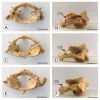Anatomical Variation and Morphometric Study on Foramen Transversarium of the Upper Cervical Vertebrae in the Thai Population
- PMID: 33355844
- PMCID: PMC8561159
- DOI: 10.31616/asj.2020.0406
Anatomical Variation and Morphometric Study on Foramen Transversarium of the Upper Cervical Vertebrae in the Thai Population
Abstract
Study design: Foramen transversarium (FT) and foramen arcuale (FA) of upper cervical vertebrae (C1 and C2) in the Thai population were investigated for variation and morphometry.
Purpose: This study aimed to reveal the morphometry of FT and FA in the Thai population.
Overview of literature: The FT and FA are structures found in the upper spine that support the vertebral neurovascular system. Clinically, the surgical approaches to achieve upper cervical stability can be affected by spine variations. FT and FA morphometries have been documented to vary by nationality. However, such reports have been limited in the Thai population.
Methods: The FT and FA of dried C1 and C2 vertebrae (identified bones; n=107, males=53 and females=54) were observed and measured using a Digital Vernier Caliper (Mitutoyo, Kawasaki, Japan). Anteroposterior (AP) and transverse diameters of the left and right FTs (n=214) were measured and compared between sexes. Variations and types of FT and FA found on the upper vertebrae were recorded and classified.
Results: The FT shape of the Thai C1 was AP elliptical, while of that of C2 was transverse elliptical. Compared to females, both diameters of the upper spine were significantly greater in males except for the AP diameter of C2 on the right side. All diameters were significantly different in both sexes and sides except for the AP diameter of C1 and C2. A common type of FT classified in C1 was type 2 (male [69.81%], female [79.63%]) whereas for C2 it was type 1 (male [63.21%], female [59.26%]). Moreover, an incomplete osseous bridge was a major FA subtype observed in the Thai spine.
Conclusions: FT morphometry has an elliptical shape and diameters are greater in males. The FT and FA variations identified in this study will be useful for surgeons treating vertebral neurovascular injuries of the posterior upper cervical spine in the Thai population.
Keywords: Cervical upper spine; Classification; Foramen arcuale; Foramen transversarium; Variation.
Conflict of interest statement
No potential conflict of interest relevant to this article was reported.
Figures




Similar articles
-
Anatomical variations of the foramen transversarium in cervical vertebrae: findings, review of the literature, and clinical significance during cervical spine surgery.Eur Spine J. 2016 Dec;25(12):4132-4139. doi: 10.1007/s00586-016-4738-3. Epub 2016 Aug 23. Eur Spine J. 2016. PMID: 27554348 Review.
-
Variations in the Foramen Transversarium of Cervical Spine and Their Surgical Importance: An Osteological Study in Dried Cervical Vertebrae of North Indian Origin.Turk Neurosurg. 2022;32(1):36-42. doi: 10.5137/1019-5149.JTN.32701-20.3. Turk Neurosurg. 2022. PMID: 34169994
-
Morphometric study of cervical spinal canal and transverse foramen diameter using computed tomography: Sex difference and relationship to age in Turkish population.Medicine (Baltimore). 2023 Dec 8;102(49):e36155. doi: 10.1097/MD.0000000000036155. Medicine (Baltimore). 2023. PMID: 38065881 Free PMC article.
-
Unveiling Morphological Diversity: An Anatomical Investigation of the Foramen Transversarium in the Cervical Vertebrae.Cureus. 2024 Aug 18;16(8):e67143. doi: 10.7759/cureus.67143. eCollection 2024 Aug. Cureus. 2024. PMID: 39295713 Free PMC article.
-
Prevalence of foramen arcuale and its clinical significance: a meta-analysis of 55,985 subjects.J Neurosurg Spine. 2017 Sep;27(3):276-290. doi: 10.3171/2017.1.SPINE161092. Epub 2017 Jun 16. J Neurosurg Spine. 2017. PMID: 28621616 Review.
References
-
- Kaya S, Yilmaz ND, Pusat S, Kural C, Kirik A, Izci Y. Double foramen transversarium variation in ancient Byzantine cervical vertebrae: preliminary report of an anthropological study. Turk Neurosurg. 2011;21:534–8. - PubMed
-
- Lamberty BG, Zivanovic S. The retro-articular vertebral artery ring of the atlas and its significance. Acta Anat (Basel) 1973;85:113–22. - PubMed
-
- Tubbs RS, Johnson PC, Shoja MM, Loukas M, Oakes WJ. Foramen arcuale: anatomical study and review of the literature. J Neurosurg Spine. 2007;6:31–4. - PubMed
-
- Zibis AH, Mitrousias V, Baxevanidou K, Hantes M, Karachalios T, Arvanitis D. Anatomical variations of the foramen transversarium in cervical vertebrae: findings, review of the literature, and clinical significance during cervical spine surgery. Eur Spine J. 2016;25:4132–9. - PubMed
-
- Abdul RS, Lazarus L, Rennie C, Satyapal KS. The foramen transversarium of typical and atypical cervical vertebrae: morphology and morphometry. Int J Morphol. 2018;36:1439–46.
LinkOut - more resources
Full Text Sources
Research Materials
Miscellaneous

